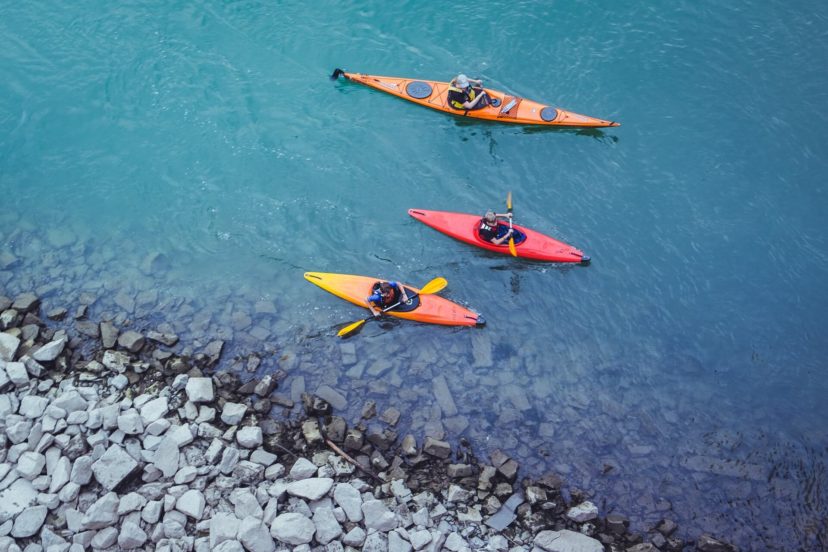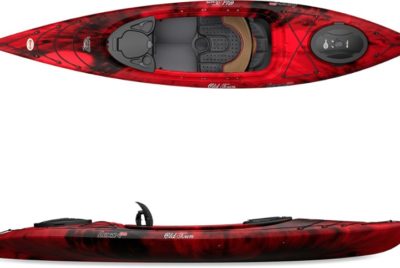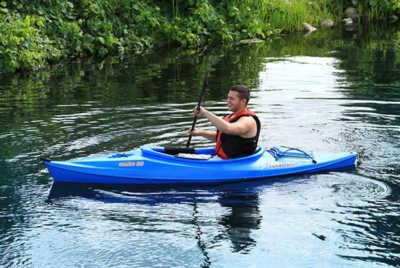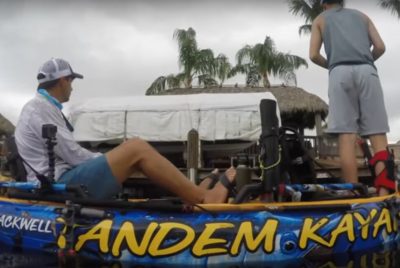10 Best Kayaks For Beginners Reviewed

With all the various kayak options to choose from these days, determining which one to use can be a challenge – especially if you’re a newcomer to the activity. The best beginner kayaks aren’t typically appropriate for people who want to be gnarly on the waters, and/or take memorable journeys across the open water. However, they can provide you with a safe and stable way of enjoying the time you spend on slow-motion rivers and calm seas.
This article will tell you precisely what to keep an eye out for when browsing beginner kayaks. We also name some of our favorite selections.
The Best Beginner Friendly Kayaks: 10 Simple-to-Paddle Choices For Kayaking Starters
Islander Kayaks Fiesta Recycled Kayak
Completely made out of recycled plastic, the Fiesta was manufactured in Somerset, UK. This is an environmentally-friendly kayak you can sit in, and is ideal for beginner paddlers. Its broad hull offers sufficient stability, and a bow with a V-shape aides with tracking. This kayak happens to be better suited for sheltered water paddling, even with its shaped hull. It has a mounted seat and a versatile backrest. The foot brace is adjustable, offering you plenty of comfort when you’re on the open water for several hours. Also, a large weight capacity and generous cockpit give larger paddlers optimal comfort.
Weight: 19 kg/42 pounds.
Weight capacity: 130 kg/286 pounds.
Advantages
Quite stable.
Compatible weight.
Environmentally-friendly: made from completely recycled plastic.
The cockpit is comfortable.
Disadvantages
Tracking could use some improvement.
Sun Dolphin Aruba 10
This kayak is great for beginners. It is incredibly affordable and available in stores everywhere, including online. The Aruba 10 is lightweight, so you won’t throw your back out when you are loading/unloading it. Easy maneuvering optimizes comfort. The Aruba 10 doesn’t come with extra features or accessories. However, the seat is padded, and each foot brace is adjustable, allowing you to customize your fit.
Weight capacity: 113 kg/250 pounds.
Weight: 18 kg/40 pounds.
Advantages
Affordable.
Seven color choices.
Lightweight and maneuverable.
Disadvantages
Less durable in comparison to high-end kayaks.
Lack of accessories.
Oru Kayak Beach LT
While it is one of the costlier kayaks on this list, the Beach LT happens to be the most compatible, by far. It weighs 11.8 kg/26 pounds, making it a very lightweight kayak – perhaps one of the lightest out there! You can fold up the kayak and have it set up within five minutes or less. Packing it away takes even less time. Once the kayak is folded, you can carry it into a backpack (purchased separately) or store it in a small car’s trunk. You won’t have to create storage space for the kayak in your home, which makes it the perfect choice for people who prefer to paddle solo. The beach LT paddles quite nicely on gentle estuaries and rivers, sheltered bays, and calm lakes. Also, it serves as a great icebreaker – anybody who notices this kayak tends to inquire about it!
Weight capacity: 136 kg/300 pounds.
Weight: 11.8 kg/26 pounds
Advantages
Very portable – simple to transport and carry by yourself.
Quite stable.
Moves fast in mild conditions.
Simple to paddle.
Easy to fold up.
Super lightweight.
Disadvantages
Not ideal in choppy or windy conditions.
Costly.
Perceptions Pescador Pro
This kayak includes a few individual storage choices, such as the waterproof limited storage container directly behind the seats. If you are looking for plenty of secure storage space, the Pescador is worth considering. It comes with a paddle park and a molded-in cupholder – a couple of bonus features that add convenience to your trip without additional bulk or weight. Besides ample storage room, the Pescador happens to be very stable on the water. It turns (tracks) easily, and features a stadium-like seat that is incredibly comfortable.
Weight capacity: 170 kg/375 pounds.
Weight: 29 kg/64 pounds.
Advantages
Tracks smoothly.
Detachable seat.
Plenty of storage.
Disadvantages
Costly.
Oldtown Canoes and Kayaks Dirigo 106
This lightweight kayak is built to last. It comes with convenient features – a paddle keeper being one of them, allowing you to move on the water hands-free. The Dirigo 106 also has waterproof actions, rod holders (optional) for simple fishing, and thigh pads that can optimize comfort for lengthy trips.
Weight capacity: 159 kg/350 pounds.
Weight: 23 kg/50 pounds
Advantages
Quite durable.
Best fishing kayak for beginners.
Experienced kayakers will appreciate the Dirigo 106, too.
Disadvantages
Costly.
Ocean Kayak Malibu
Each of these kayaks provides sufficient stability for beginners. With that said, the Malibu is one of our favorite kayaks because it allows you to sit right on top of it. Similar to the 2-person model, this kayak was designed not to flip, which makes it a popular choice among new kayakers. As far as paddling goes, this is a great beginner kayak. It also comes with several appealing features that make your initial strokes more convenient and comfortable. The QuickStash splash-resistant dry hatch stores essentials while keeping them nearby. There are a few cupholders and paddle rests that are molded in, too. You will also find bungee storage on both the rear and front of this kayak. Versatile footholds are not included, though. The Malibu happens to be a favorite among groups because they are stackable.
Weight capacity: 147 kg/325 pounds.
Weight: 23 kg/50 pounds.
Advantages
Plenty of storage.
Stacks effortlessly on other kayaks.
Quite stable.
Disadvantages
Not ideal for long-distance coverage.
Sevylor Quikpak K1
If you are interested in kayaking, but you don’t want to spend too much on an actual kayak, or if you lack the storage for a conventional kayak, you might want to check out Sevylor’s Quikpak K1. It is comprised of five different inflatable sections. Further, it is compact enough to fit in a backpack or small carrier. That makes transportation and storage of this kayak effortless. It is the cheapest kayak on this list – by more than 50%! Suffice it to say, the Quikpak K1 is an ideal choice for infrequent kayakers, as well as anybody that wants to have a backup. Since it is lightweight, waves and wind are not kind to this kayak. However, for what it weighs, the material it’s made from is durable enough.
Weight capacity: 181 kg/400 pounds.
Weight: 8.1 kg/18 pounds.
Advantages
Portable storage design.
Affordable.
Fast set up.
Disadvantages
Better for calm, slow waters.
It isn’t very hard to get blown off course.
Wilderness Systems Pungo 120 Kayak
This high-quality kayak also happens to be the costliest. It is simple enough for beginners to use while being sufficiently sleek for more seasoned kayakers. It remains stable and straight no matter how rough the waters are, and is simple to carry and load. Drainage holes and ventilation on the seats make breathability a nonissue, no matter how long your trips are. You’ll end up using this kayak for years because of its top-of-the-line construction. The Pungo 120 was built to last.
Weight capacity: 148 kg/325 pounds.
Weight: 22 kg/49 pounds.
Advantages
Ideal for beginner kayakers in addition to intermediate ones.
Durably constructed.
Rough water stability.
Disadvantages
Lack of drain plug.
Costly.
Best Beginner Tandem Kayaks
Ocean Kayak Malibu Tandem
It doesn’t get any more affordable than the Malibu Tandem. Its size is just right for single paddlers, but two people can comfortably sit in it, too. That makes the Malibu Tandem a multipurpose option and perfect for family adventures. This isn’t a light kayak by any means, but it isn’t very hard to maneuver on the water, which is impressive considering its size. As far as kayaks you can sit on go, the Malibu Tandem will protect you from sprays and splashes just as well as other kayaks can. Going into this kayak and getting out of it is a breeze. If you wish to take a swim on a whim, it won’t be a chore to do so.
Weight capacity: 227 kg/500 pounds.
Weight: 31 kg/68 pounds.
Advantages
Affordable.
A couple of adults and one child can comfortably fit in it.
Portable design.
Disadvantages
Without additional gear, this is not a good choice for kayaking in cold water.
Not lightweight.
Oldtown Dirigo 155 Tandem Kayak
The Dirigo 155 is more than 15 feet long, making it the largest kayak on this list. In spite of that, though, it offers unparalleled flexibility for families who want to spend some time on the open water. You can sit on this kayak, which is developed for a couple of people. However, paddling solo is fairly easy via the stern seat, which is adjustable (you can move it forward to optimize solo paddling). Further, the kayak is spacious enough to accommodate one child in addition to a couple of adults. It includes a detachable child seat that can be snapped in (for children 60 pounds or under), allowing them to sit on the cockpit stern.
The Dirigo 155 comes with a number of storage options, cupholders, a small hatch near the bow (which is watertight), one stern hatch, bungee storage (near the stern and bow), and paddle holders. It also includes foot braces you can adjust. The Dirigo 155 offers decent stability, making an ideal choice for rookies and experienced kayakers alike.
Weight capacity: 215 kg/475 pounds.
Weight: 33 kg/72 pounds.
Advantages
Great for newcomers and people who want to improve their kayaking experience.
Decent storage options.
Comfortable.
Quick – ideal for distances.
Flexible for families.
Disadvantages
Big and heavy.
Less stability in comparison to tandem kayaks you can sit on.
Costly.
What to Keep Your Eye Out for When Looking at Beginner Kayaks
Before you commit to a particular kayak, there are a number of things you need to factor in:
Storage
Planning to use the kayak for multi-day or all-day trips? You’ll require one that has storage built into it. For a fast day trip, though, consider something lightweight – one that has more than basic storage.
The primary storage choices you have when it comes to beginner kayaks include:
Watertight hatches should be embedded into the kayak. They should have lids you can screw on, which can help you secure your gear in place safely (and keep it fairly dry). Mind you, you’ll have to store your gear in bags that are dry.
Bungees should be connected to the kayak’s top portion. These elastic aided bungees help you secure and store gear on your kayak. As far as kayaks you can sit on go, bungees typically lash over indented spaces, giving you more storage. Kayaks you can sit on come with bungees that are latched over the hull. For each scenario, your gear will need to be stored in dry, waterproof bags.
Weight and Size
The weight and size of the kayak are quite important – particularly if you plan on loading it onto an automobile on your own. Is there enough storage space for it in your house? Is your automobile large enough to bring it from one place to another? Sevylor’s QuickPak K1 is lightweight because it is inflatable. Also lightweight is the Oru kayak, which is very simple to store and transport because you can fold it up. With that said, if you’re in search of a more conventional style, check out the beginner kayak from Emotional Glide.
Weight Limits
It is prudent to check out what the weight limits are of any kayak you are interested in buying. You need to make sure that it is capable of supporting your body, your gear, and the people kayaking with you. Don’t forget – some people prefer paddling with a dog by their side! Kayaks you can sit on happen to be the ideal choice for this.
Comfort Levels
It is hard to establish a kayak’s comfort level without actually testing it out, but you can use a number of measurements to get a sense of what to expect. For starters, if your legs are notably short or long, the model you should be looking for should have either foot braces or adjustable seats (one such example: the Aruba 10 from Sun Dolphin). The seat’s width is also something to consider – particularly if your bottom needs plenty of room.



